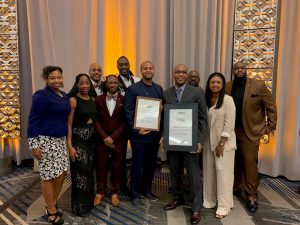Jonathan Moody Recreates MLK Library Journey at NOMA
 When Moody Nolan President Jonathan Moody began conceptualizing Columbus’ new Martin Luther King Library more than seven years ago, he knew where to turn for inspiration: the writings of Dr. King himself.
When Moody Nolan President Jonathan Moody began conceptualizing Columbus’ new Martin Luther King Library more than seven years ago, he knew where to turn for inspiration: the writings of Dr. King himself.
On Oct. 17, Jonathan took his audience along that journey when he led a course on “The Design and Legacy of Dr. Martin Luther King, Jr.” at the National Organization of Minority Architects (NOMA) annual conference in New York City.
“We must utilize the community action groups and training centers now proliferating in some slum areas to create not merely an electorate, but a conscious, alert and informed people,” Dr. King once wrote.
That philosophy, Jonathan told NOMA attendees, led to the new library as “a place of connection and reflection that provides the community with information and resources.”
The MLK Library was the first in the nation named after Dr. King when the original building opened in 1968. Martin Luther King Sr. was the featured speaker then.
The dedication of the new building on Oct. 18, 2018 – almost exactly a year before Jonathan’s NOMA presentation – was keynoted by Martin Luther King III, Dr. King’s grandson. While the words of Dr. King permeated both dedications, they also permeated the planning of the new library in Columbus’ Near East Side neighborhood, Jonathan told his class.
The inscription found on the MLK Monument in Washington, D.C. – “Out of a mountain of sorrow, comes a stone of hope” – helped inform materiality and building form, he noted. Early studies drove a compact massing with clerestory lighting and transparency from the north and east. The building’s lower masses consist of pieces reminiscent of nearby institutional buildings, including the historic East High School.
One of the challenges Moody Nolan faced, Jonathan told the class, was to achieve an iconic expression of Dr. King that was adaptable over time. Jonathan and his team accomplished this using a projected image of Dr. King, created graphically from the names of all the small donors who made the branch possible.
“Iconic civil rights moments, inspiring neighborhood figures and other images are constantly changing and updated as appropriate,” Jonathan says. “Ultimately, the design of the building is an exploration of the theme of connection and change. What does that mean and how is it manifested in the architecture of a place? Can the library be a place where people come together to facilitate positive and impactful change? Dr. King thought so.”